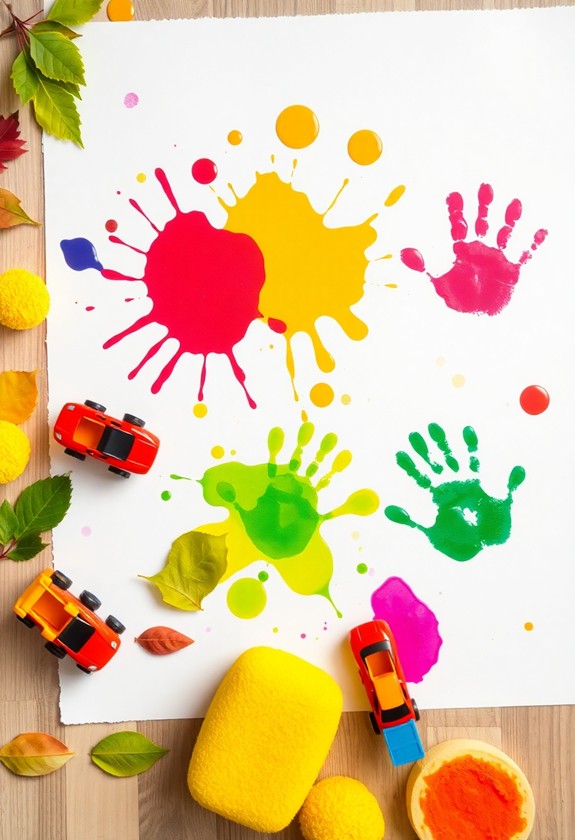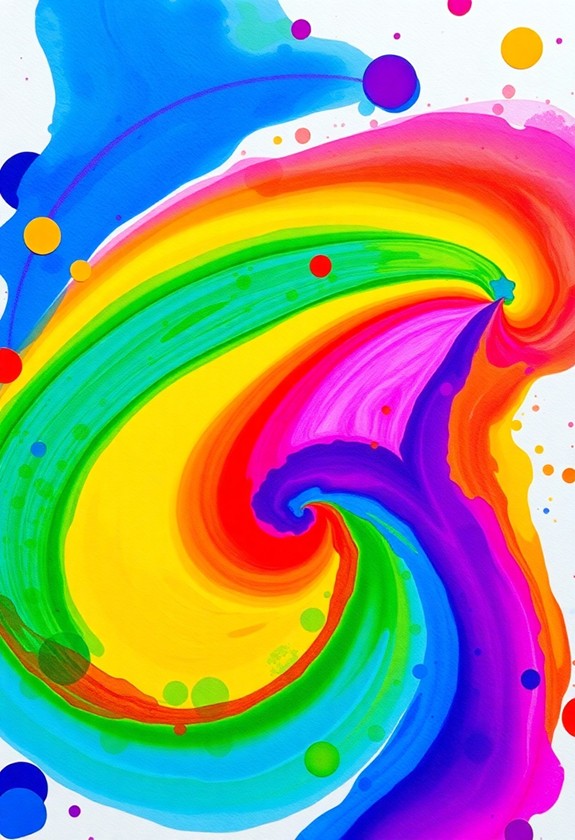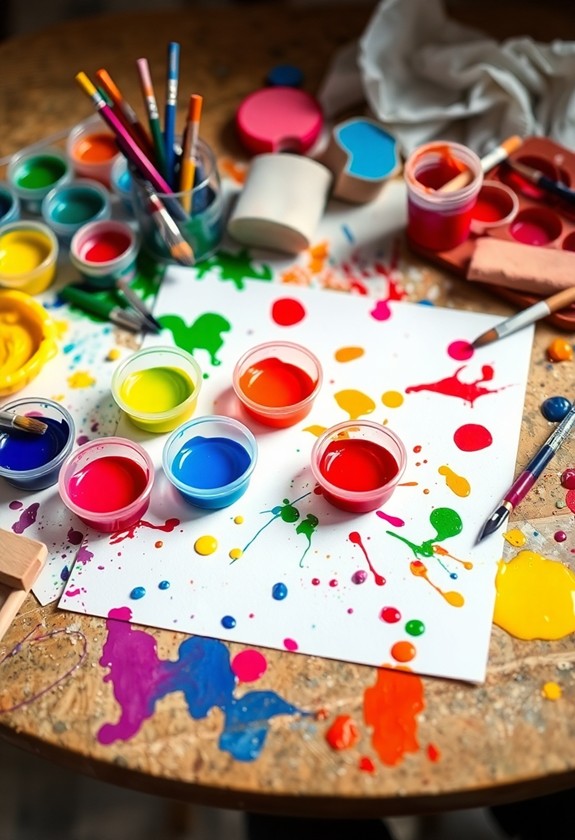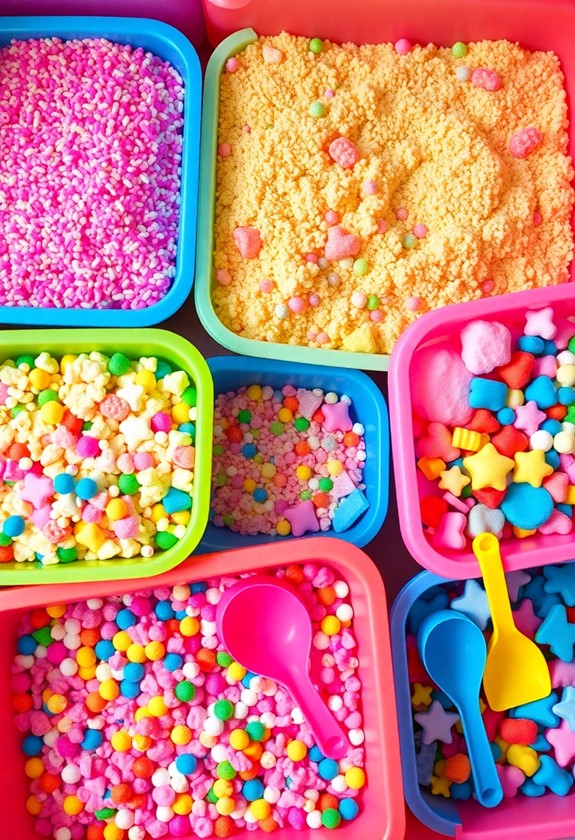Want to enchant your toddler group with sensory art? Try these exciting projects! Rainbow spaghetti painting lets little hands squish and smear colorful noodles. Scented play dough creations engage noses and fingers. Textured collages investigate fuzzy, bumpy, and smooth materials. Sand art brings beach fun indoors, as nature sensory bins encourage outdoor investigation. Get messy with shaving cream canvas art or cool down with ice cube painting. Don't forget musical fun with homemade sensory bottle shakers! These activities develop fine motor skills, encourage creativity, and provide rich sensory experiences. Plus, they're a blast for grown-ups too! Immerse yourself for more toddler-friendly art adventures!
Creative Highlights
- Rainbow spaghetti painting engages multiple toddlers through colorful, messy exploration and texture investigation.
- Scented play dough creations allow group interaction while stimulating senses of touch and smell.
- Bubble wrap stamping provides a shared sensory experience with sound, texture, and visual elements.
- Nature sensory bins encourage collaborative exploration of outdoor elements, promoting tactile engagement and environmental learning.
- Sensory bottle shakers foster group musical activities, enhancing rhythm and motor skills through interactive play.
Rainbow Spaghetti Painting
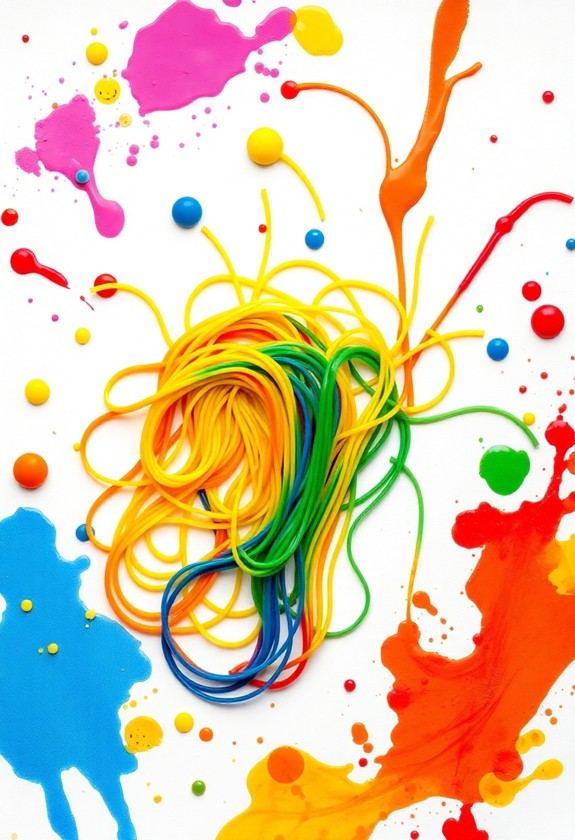
Rainbow spaghetti painting is a hands-on sensory experience that'll delight toddlers and stimulate their creativity. It's messy, fun, and oh-so-colorful! This activity enhances fine motor skills and encourages imaginative play, supporting emotional development. Here's how to set it up:
- Cook spaghetti until soft
- Divide into bowls
- Add food coloring to each bowl
- Mix well
Now, spread out a large plastic sheet and let the kiddos go wild! They can squish, squash, and smear the noodles on paper to create lively masterpieces. Watch their eyes light up as they investigate different textures and colors. But wait, there's more! Try these fun variations:
- Add glitter for extra sparkle
- Use tongs for fine motor practice
- Mix in scented oils for an olfactory twist
Scented Play Dough Creations
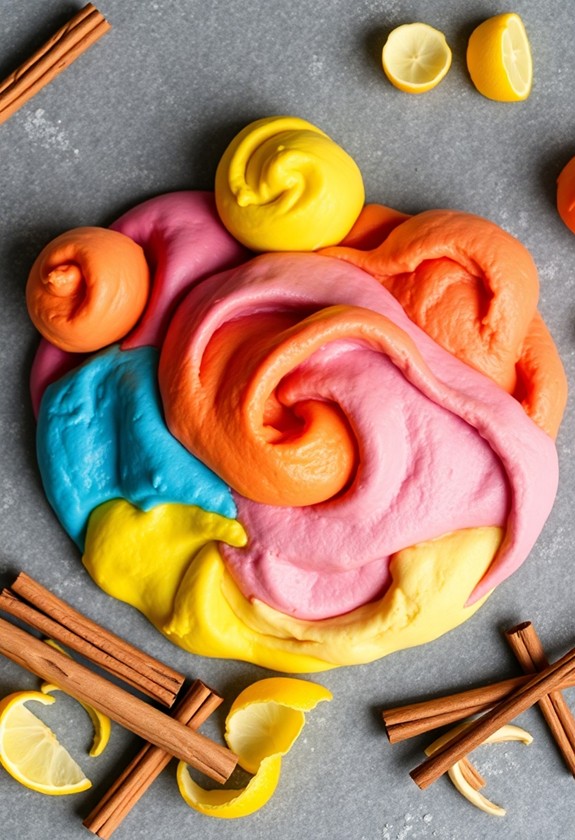
Countless toddlers adore playing with play dough, but adding scents takes this classic activity to a whole new level. It's time to get your hands messy and create some aromatic masterpieces! Here's how to make scented play dough:
- Mix flour, salt, and water in a bowl
- Add food coloring for lively hues
- Knead in crucial oils or extracts for scent
Choose scents like lavender, vanilla, or peppermint. The possibilities are endless! This activity is perfect for enhancing fine motor skills and promoting cognitive development in young children. Now, let the sensory exploration begin. Encourage your little ones to:
- Roll out "spaghetti" strands
- Cut shapes with cookie cutters
- Build 3D sculptures
As they play, they'll be developing fine motor skills and releasing their creativity. Plus, the delightful scents will make this activity a nose-tastic adventure! Don't be surprised if you find yourself joining in the fun too!
Textured Collage Making
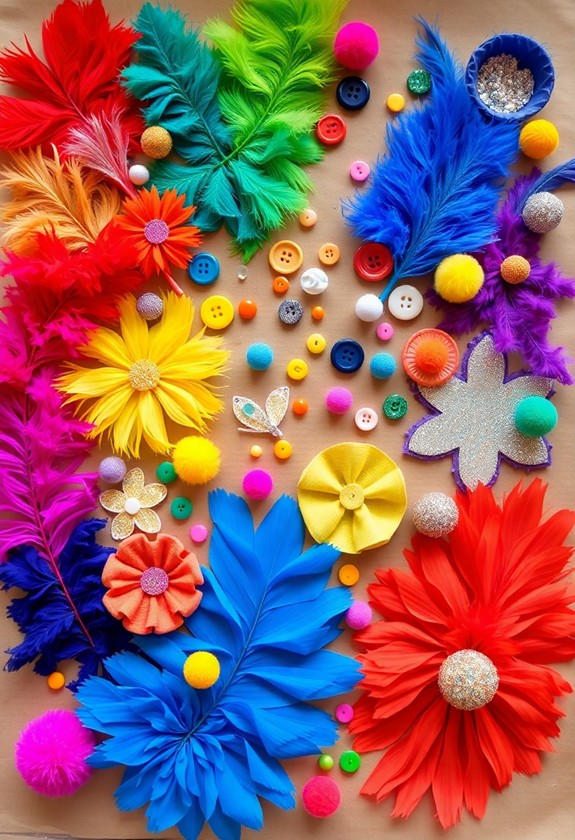
As play dough engages touch and smell, textured collage making expands a toddler's sensory experience even further. It's a fantastic way to examine different textures, colors, and shapes! This activity as well fosters emotional bonding within families and encourages problem-solving skills as children decide where to place each material. Gather a variety of materials like:
- Soft cotton balls
- Rough sandpaper
- Smooth fabric scraps
- Crunchy dry pasta
Let your little ones go wild with glue and creativity! They'll love feeling the different textures as they stick them to paper. This activity isn't just fun, it's as well great for developing fine motor skills and hand-eye coordination. Plus, it's a wonderful opportunity to introduce new vocabulary words like "fuzzy" or "bumpy." As they create their masterpieces, encourage them to describe what they're feeling. You'll be amazed at how quickly they learn and grow through this tactile adventure!
Edible Finger Paint Fun
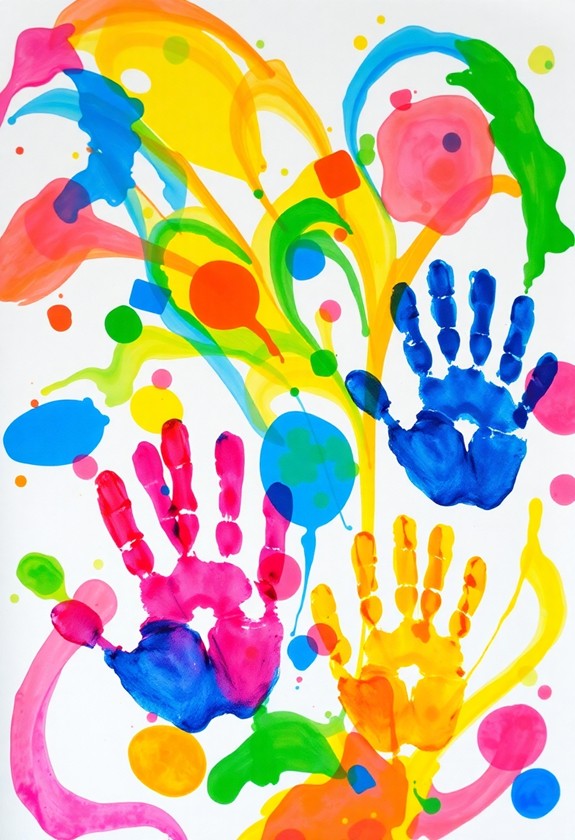
Moving from dry materials to wet ones, edible finger paint offers a delightfully messy and safe sensory experience for toddlers. You'll love watching their faces light up as they squish and smear colorful, tasty paints! This activity not only promotes sensory play but additionally improves fine motor skills and color recognition. Here's how to whip up this finger-lickin' good art project:
- Mix equal parts cornstarch and water
- Add a dollop of food coloring
- Stir until smooth
Voilà! You've got edible paint that's safe for curious little artists. Spread butcher paper on the floor, plop down some paint, and let the fun begin! Watch as they create masterpieces with their hands, feet, and maybe even their noses. But wait, there's more! Try these finger-painting variations:
- Use pudding for a sweet twist
- Mix in spices for scent-sational art
- Add texture with rice or oatmeal
Get ready for a colorful, giggly, messy adventure!
Sand Art Exploration
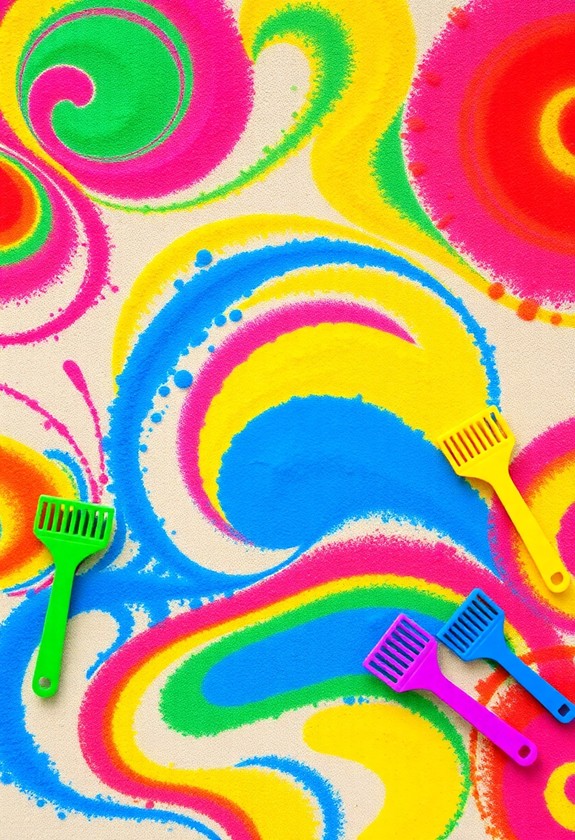
Texture takes center stage in sand art investigation, offering toddlers a unique sensory experience. It's time to get hands-on with this versatile medium! You'll be amazed at how engaged your little ones become when they plunge into sand art. This screen-free entertainment promotes social interaction and creative expression during enhancing fine motor skills. Here are some exciting ways to investigate:
- Colored sand layering in clear jars
- Sand painting with glue and various sand colors
- Sand castle building on trays
- Sand drawing on light tables
Let's get sandy! Start by setting up a designated area – outdoors is great, but indoors works too with a large tarp. Pour different colored sands into shallow containers. Provide tools like funnels, scoops, and small rakes. Watch as your toddlers dig in, feeling the gritty texture between their fingers. They'll love creating patterns, shapes, and even 3D structures. Sand art isn't just fun – it's a fantastic way to develop fine motor skills and creativity!
Bubble Wrap Stamping
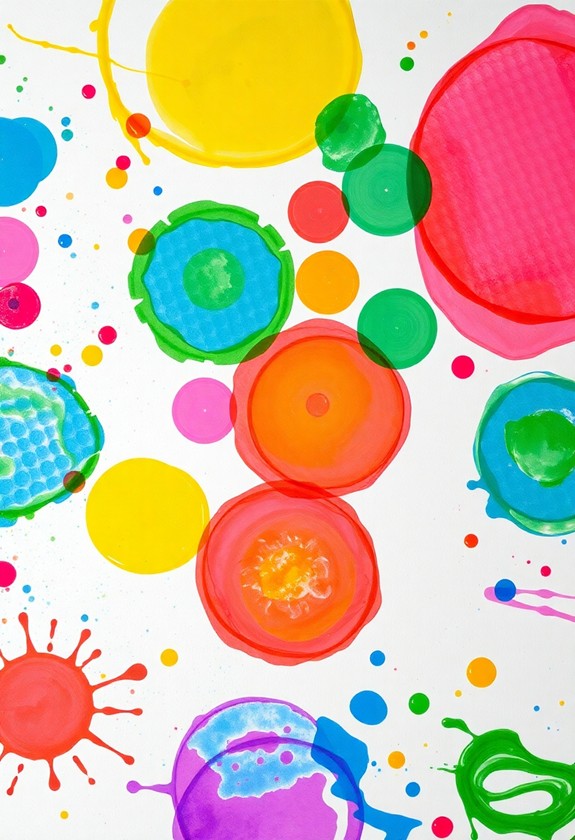
Now it's time to pop into a new sensory adventure! Bubble wrap stamping is a fantastic way to engage your toddlers' senses and create unique art. Here's how to do it:
- Gather supplies:
- Bubble wrap
- Paint
- Paper
- Scissors
- Soft, crumbly soil
- Smooth pebbles and rough pinecones
- Fragrant flowers and herbs
- Crunchy leaves in various shapes
- Large sheets of paper or canvas
- Shaving cream (non-menthol)
- Food coloring or washable paint
- Squeegees or rulers
- It's a chilly thrill for little fingers
- Creates unique, melty masterpieces
- Teaches color mixing as cubes melt together
- Encourages fine motor skills
- Empty plastic bottles
- Colorful beads, buttons, or sequins
- Dry rice or beans
- Glitter (optional)
Watch their eyes light up as they uncover the bubbly patterns! Encourage them to experiment with colors and textures. They'll love feeling the squishy bubbles and hearing the satisfying pops as they create. This activity isn't just fun – it's also excellent for developing fine motor skills and color recognition. So, let's burst into creativity and make some bubble-tastic masterpieces!
Nature Sensory Bins
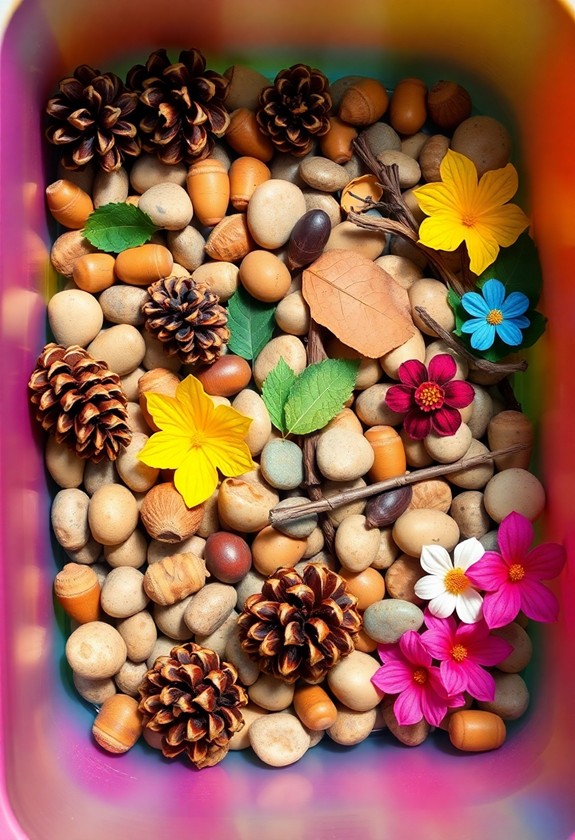
From bubble wrap to the great outdoors, let's examine nature sensory bins! These magical containers are bursting with natural treasures for little hands to investigate. You'll love watching your toddlers plunge into a world of textures, colors, and smells!
To create your own nature sensory bin, grab a shallow container and fill it with:
Add some scoops, cups, and small toys for extra fun! Your tiny adventurers will be thrilled to dig, pour, and sort these natural wonders. They'll learn about their environment as they engage their senses. It's a win-win!
Shaving Cream Canvas Art
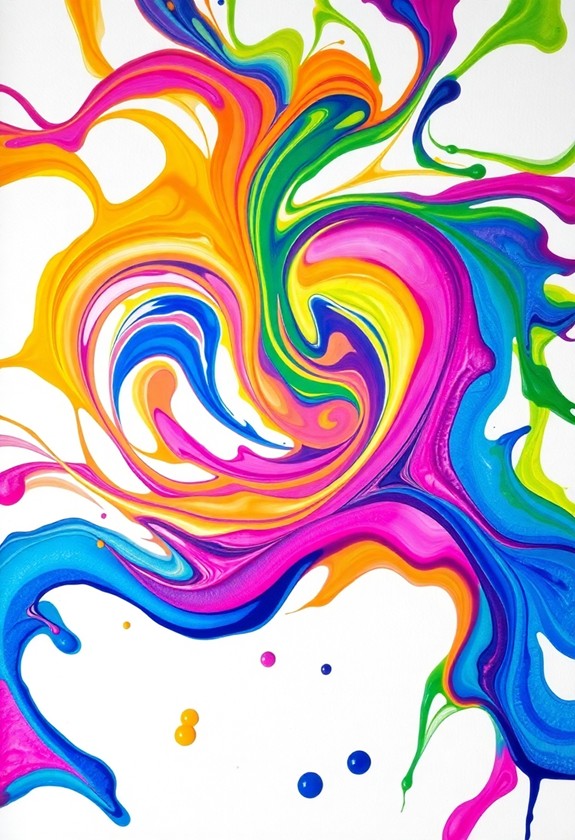
Shaving cream canvas art offers a delightfully messy and sensory-rich experience for toddlers. It's time to get your hands dirty and create some foamy masterpieces! Here's what you'll need:
Start by spreading a thick layer of shaving cream on the paper. Add drops of color and watch as your little artists swirl and blend! They can use their fingers, paintbrushes, or even toy cars to make patterns. What a tactile adventure!
When they're done, use the squeegee to scrape off the excess cream. Voila! A unique, marbled creation emerges. But wait, there's more! You can stamp the removed cream onto another sheet for a bonus artwork. Double the fun, double the mess!
Ice Cube Painting
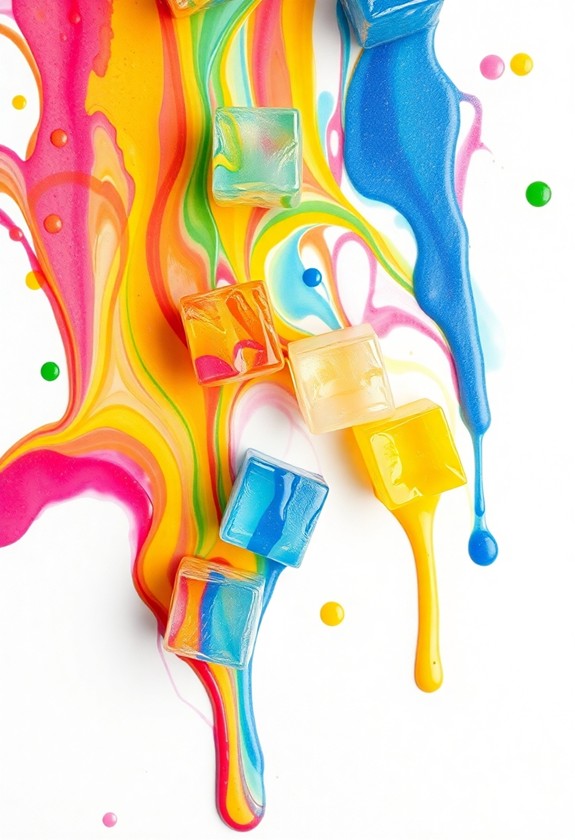
After warming up with shaving cream, let's cool things down with ice cube painting! This frosty art technique is a blast for toddlers and helps develop their sensory skills. You'll need ice cube trays, food coloring, popsicle sticks, and thick paper.
Here's why ice cube painting is awesome:
Mix food coloring with water, pour into trays, add sticks, and freeze overnight. When you're ready to paint, pop out the colorful cubes and let your toddlers go wild! Watch as they drag the icy colors across the paper, creating cool swirls and patterns. It's a revitalizing way to beat the heat and make art at the same time!
Sensory Bottle Shakers

Tiny hands love to shake things up, and sensory bottle shakers are the perfect way to engage your toddler's senses. Let's create these magical musical marvels together! You'll need:
First, clean and dry your bottles. Then, let the fun begin! Fill each bottle about 1/3 full with your chosen materials. Mix and match colors and textures for a sensory explosion! Secure the lids tightly with strong glue.
Now, it's shake, rattle, and roll time! Encourage your little ones to:
- Shake to the beat of music
- Make up silly movements
- Use them as pretend microphones
These shakers aren't just fun – they're fantastic for developing motor skills and rhythm. Plus, they're a blast for the whole family!
Curious Little Questions
How Can I Adapt These Projects for Children With Sensory Sensitivities?
One size doesn't fit all in regards to sensory projects! You can adapt activities for kids with sensitivities by:
- Offering choices: Let them pick textures they're comfortable with
- Going gradual: Start small and build up slowly
- Creating safe spaces: Have quiet areas for breaks
- Using tools: Provide brushes or spoons for those who don't like messy hands
- Adjusting intensity: Soften sounds, dim lights, or use milder scents
What Are the Best Ways to Document and Display Group Art Projects?
You've got so many awesome ways to showcase your group's masterpieces! Here are some fun ideas:
- Snap photos and create a digital gallery – it's picture perfect!
- Make a giant collage on a bulletin board – talk about a wall of fame!
- String up a clothesline and clip the art – it's a hanging exhibition!
- Create a class scrapbook – memories that'll last forever!
- Set up a mini art show for parents – they'll be blown away!
Don't forget to label each piece with the artists' names. It's time to let those creations shine!
How Do I Manage Cleanup Efficiently After Messy Group Art Activities?
Envision this: You're a referee blowing a whistle to signal cleanup time! Here's how to manage the mess efficiently:
- Assign cleanup roles: Make it a game!
- Use big buckets or bins for easy sorting
- Keep wipes handy for quick spills
- Cover surfaces with newspaper beforehand
- Encourage kids to help – it's fun and teaches responsibility
And don't forget the magic cleanup song! Sing together as you tidy. Remember, a little planning goes a long way. You've got this, cleanup champion!
Are There Any Age-Appropriate Alternatives for Toddlers Who Put Everything in Their Mouths?
For little ones who love to taste-test everything, there are plenty of safe alternatives. Try these fun ideas:
- Use edible finger paints made from yogurt and food coloring
- Create sculptures with play dough made from flour and salt
- Make collages with cheerios, fruit loops, or other safe cereals
- Paint with water on sidewalks or dark construction paper
- Investigate textures with sensory bins filled with rice, pasta, or beans
These activities are just as engaging but won't cause tummy troubles if sampled. Get creative and have a blast!
How Can I Incorporate Learning Objectives Into These Sensory Art Projects?
Imagine a garden where every flower teaches a new lesson—that's what your sensory art projects can be! You can easily sprinkle learning into these fun activities. Try color-mixing experiments to teach basic science. Count objects or sort shapes to boost math skills. Use nature items to investigate textures and learn about the environment. Don't forget language development—describe what you're doing together! With a little creativity, you'll turn playtime into a lively learning adventure. It's like magic!

